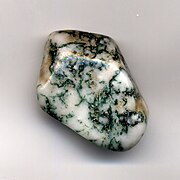Chalcedony
Chalcedony is a cryptocrystalline form of silica, composed of very fine intergrowths of the minerals quartz and moganite[2]. These are both silica minerals, but they differ in that quartz has a trigonal crystal structure, whilst moganite is monoclinic. Chalcedony has a waxy luster, and may be semitransparent or translucent. It can assume a wide range of colors, but those most commonly seen are white to gray, grayish-blue or a shade of brown ranging from pale to nearly black. VarietiesChalcedony occurs in a wide range of varieties. Many semi-precious gemstones are in fact forms of chalcedony. The more notable varieties of chalcedony are as follows: AgateAgate is a variety of chalcedony with multi-colored concentric banding. CarnelianCarnelian (also spelled cornelian) is a clear-to-translucent reddish-brown variety of chalcedony. Its hue may vary from a pale orange, to an intense almost-black coloration. Similar to carnelian is sard, which is brown rather than red. ChrysopraseChrysoprase (also spelled chrysophrase) is a green variety of chalcedony, which has been colored by nickel oxide. (The darker varieties of chrysoprase are also referred to as prase. However, the term prase is also used to describe green quartz, and to a certain extent is a color-descriptor, rather than a rigorously defined mineral variety.) HeliotropeHeliotrope is a green variety of chalcedony, containing red inclusions of iron oxide. These inclusions resemble drops of blood, giving heliotrope its alternative name of bloodstone. A similar variety, in which the spots are yellow instead of red is known as plasma. Moss agateMoss agate (also known as tree agate or mocha stone) contains green filament-like inclusions, giving it the superficial appearance of moss or blue cheese. It is not a true form of agate, as it lacks agate's defining feature of concentric banding. MtoroliteMtorolite is a green variety of chalcedony, which has been colored by chromium. It is principally found in Zimbabwe. OnyxOnyx is a variant of agate with black and white banding. Similarly, agate with brown and white banding is known as sardonyx. History Chalcedony cameo of Titushead, 2nd Century AD As early as the Bronze Age chalcedony was in use in the Mediterranean region; for example, on Minoan Crete at the Palace of Knossos, chalcedony seals have been recovered dating to circa 1800 BC.[3] People living along the Central Asian trade routes used various forms of chalcedony, including carnelian, to carve intaglios, ring bezels (the upper faceted portion of a gem projecting from the ring setting), and beads that show strong Graeco-Roman influence. Fine examples of first century objects made from chalcedony, possibly Kushan, were found in recent years at Tillya-tepe in north-western Afghanistan. [4] Hot wax would not stick to it so it was often used to make seal impressions. The term chalcedony is derived from the name of the ancient Greek town Chalkedon in Asia Minor, in modern English usually spelledChalcedon, today the Kadıköy district of Istanbul. GeochemistryStructureChalcedony was once regarded to be a fibrous variety of cryptocrystalline quartz [5]. More recently however, it has been shown to also contain a monoclinic polymorph of quartz, known as moganite[2]. The fraction, by mass, of moganite within a typical chalcedony sample may vary from less than 5% to over 20%[6]. The existence of moganite was once regarded as dubious, but it is now officially recognised by the International Mineralogical Association[7][8]. SolubilityChalcedony is more soluble than quartz under low-temperature conditions, despite the two minerals being chemically identical. This is thought to be because chalcedony is extremely finely grained (cryptocrystalline), and so has a very high surface area to volume ratio.[citation needed] It has also been suggested that the higher solubility is due to the moganite component [6]. Solubility of quartz and chalcedony in pure waterThis table gives equilibrium concentrations of total dissolved silicon as calculated by PHREEQC using the llnl.dat database.
| ||||||||||||||||||||||||||||||||||||||||||||||||||||
Sunday, July 19, 2009
Chalcedony
Subscribe to:
Post Comments (Atom)
Followers
Blog Archive
-
▼
2009
(61)
-
▼
July
(61)
- Malachite
- Sodalite
- Lapis Lazuli
- Dumortierite
- Benitoite
- Vesuvianite
- Prehnite
- Diopside
- Amblygonite
- Dioptase
- Kyanite
- Variscite
- Fluorite
- Smithsonite
- Sphalerite
- Chrysocolla
- Cerussite
- Serpentine
- Ulexite
- Howlite
- Onyx
- Tufa
- Orbicular jasper
- Alabaster
- Coral
- Ivory
- Amber
- Rhodochrosite
- Labradorite
- Feldspar
- Hematite
- Zoisite
- Nephrite
- Jade
- asper
- Agate
- Chrysoprase
- Chalcedony
- Chrysoberyl
- Amethyst
- Quartz
- Spodumene
- Tourmaline
- Zircon
- Grossular
- Spinel
- Aquamarine - A quality stone
- Beryl
- Corundum
- Sapphire
- Ruby
- Turquoise
- Topaz
- Opal
- Peridot
- Pearl
- Emerald
- Diamond
- "Beryl"
- Amethyst
- Garnet
-
▼
July
(61)










No comments:
Post a Comment